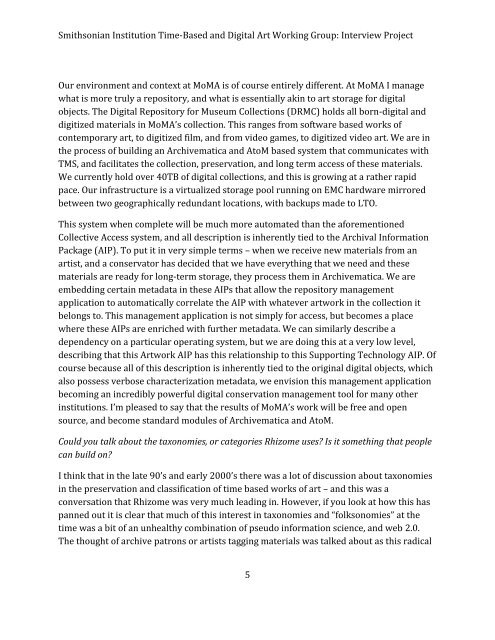Ben Fino-Radin - Smithsonian Institution
Ben Fino-Radin - Smithsonian Institution
Ben Fino-Radin - Smithsonian Institution
Create successful ePaper yourself
Turn your PDF publications into a flip-book with our unique Google optimized e-Paper software.
<strong>Smithsonian</strong> <strong>Institution</strong> Time-Based and Digital Art Working Group: Interview Project<br />
Our environment and context at MoMA is of course entirely different. At MoMA I manage<br />
what is more truly a repository, and what is essentially akin to art storage for digital<br />
objects. The Digital Repository for Museum Collections (DRMC) holds all born-digital and<br />
digitized materials in MoMA’s collection. This ranges from software based works of<br />
contemporary art, to digitized film, and from video games, to digitized video art. We are in<br />
the process of building an Archivematica and AtoM based system that communicates with<br />
TMS, and facilitates the collection, preservation, and long term access of these materials.<br />
We currently hold over 40TB of digital collections, and this is growing at a rather rapid<br />
pace. Our infrastructure is a virtualized storage pool running on EMC hardware mirrored<br />
between two geographically redundant locations, with backups made to LTO.<br />
This system when complete will be much more automated than the aforementioned<br />
Collective Access system, and all description is inherently tied to the Archival Information<br />
Package (AIP). To put it in very simple terms – when we receive new materials from an<br />
artist, and a conservator has decided that we have everything that we need and these<br />
materials are ready for long-term storage, they process them in Archivematica. We are<br />
embedding certain metadata in these AIPs that allow the repository management<br />
application to automatically correlate the AIP with whatever artwork in the collection it<br />
belongs to. This management application is not simply for access, but becomes a place<br />
where these AIPs are enriched with further metadata. We can similarly describe a<br />
dependency on a particular operating system, but we are doing this at a very low level,<br />
describing that this Artwork AIP has this relationship to this Supporting Technology AIP. Of<br />
course because all of this description is inherently tied to the original digital objects, which<br />
also possess verbose characterization metadata, we envision this management application<br />
becoming an incredibly powerful digital conservation management tool for many other<br />
institutions. I’m pleased to say that the results of MoMA’s work will be free and open<br />
source, and become standard modules of Archivematica and AtoM.<br />
Could you talk about the taxonomies, or categories Rhizome uses? Is it something that people<br />
can build on?<br />
I think that in the late 90’s and early 2000’s there was a lot of discussion about taxonomies<br />
in the preservation and classification of time based works of art – and this was a<br />
conversation that Rhizome was very much leading in. However, if you look at how this has<br />
panned out it is clear that much of this interest in taxonomies and “folksonomies” at the<br />
time was a bit of an unhealthy combination of pseudo information science, and web 2.0.<br />
The thought of archive patrons or artists tagging materials was talked about as this radical<br />
5
















